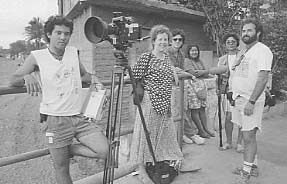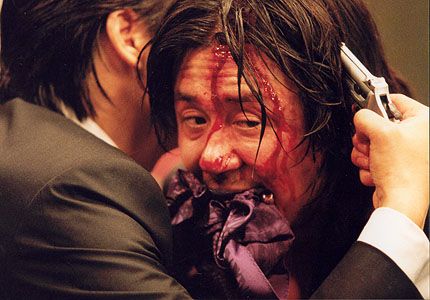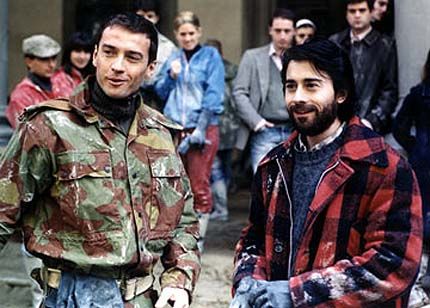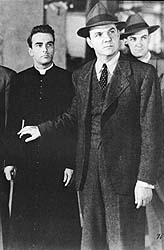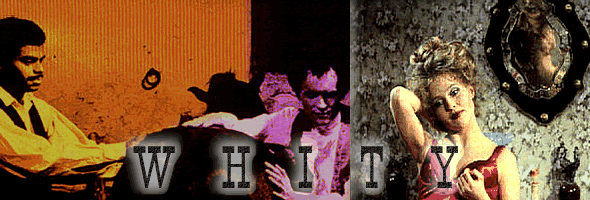 Larry Clark’s latest film, Wassup Rockers (2005), opens with a promising split-screen sequence: two shots of Jonathan (Jonathan Velasquez), a Hispanic teenager, taken from different angels, as he introduces himself. The left screen, like an attentive listener, is focused on his face while Jonathan talks directly to the camera. The right screen is taken from an askew angle, and the camera does not make eye contact with Jonathan. This shot is taken from a little further back than its counterpart, and his teenage torso is the focal point. There is a voyeuristic quality to the shot, and it idealizes the teenager’s young sexuality. This tension between accurately depicting youth culture (the left screen) and idealizing it (the right screen) is a great way the start off the movie. Sadly, the conflict ends halfway through the movie when idealization and fantasy overrule reality, and the storyline waxes ridiculous one too many times for Wassup Rockers to be believable.
Larry Clark’s latest film, Wassup Rockers (2005), opens with a promising split-screen sequence: two shots of Jonathan (Jonathan Velasquez), a Hispanic teenager, taken from different angels, as he introduces himself. The left screen, like an attentive listener, is focused on his face while Jonathan talks directly to the camera. The right screen is taken from an askew angle, and the camera does not make eye contact with Jonathan. This shot is taken from a little further back than its counterpart, and his teenage torso is the focal point. There is a voyeuristic quality to the shot, and it idealizes the teenager’s young sexuality. This tension between accurately depicting youth culture (the left screen) and idealizing it (the right screen) is a great way the start off the movie. Sadly, the conflict ends halfway through the movie when idealization and fantasy overrule reality, and the storyline waxes ridiculous one too many times for Wassup Rockers to be believable. The story focuses on Jonathan and his friends, all of them from the same neighborhood in South Central Los Angeles and who love to skateboard. The first half of the movie is rather whimsical, a series of vignettes about their daily lives: waking up, lifting weights, band practice, girlfriends, and plenty of skateboarding. These are actions without consequences, and the lack of heavy-handed drama is a welcome relief. At the same time, there is an element of grit that separates Wassup Rockers from the majority of teen fluff that circulates movie theaters: these skaters fall down when attempting tricks, they don’t blow their lid wondering if a girl likes them or not, and they don’t complain about their parents pressuring them into college. Freddie Prinz, Jr. is absolutely nowhere in sight.
When the group heads off to Beverly Hills for some skating, the film’s idyllic quality turns juvenile. Their adventures turn into a series of “crash moments” with different white people (who are really just variations on the same theme): cops (both un-hip and racist), girls (who think Hispanic boys are just so cute) and guys young and old (who want to beat/shoot the skaters on sight). These racial conflicts are of the shallowest variety, and the clichés aren’t handled with enough irony for them to be funny. Too, the situations begin to lose their veracity and often degenerate into absurdity—the epitome of which involves a drunk, rich white woman who, after Kiko (Francisco Pedrasa) flees from her bubbly bathtub, falls into the bathtub herself. The sequence ends with her reaching up to grab onto the chandelier to hoist her up, only the chandelier falls into the tub and she gets electrocuted. The joke is juvenile, and rather pointless. Her death carries no significance and only clouds the narrative: so is Kiko going to be wanted for murder? This narrative strand is never followed through, and it remains only one of several such divergences that are never cleared up.
The visual element of Wassup Rockers is an improvement over its narrative. Director Larry Clark is at times intimate (such a close-up of a girl’s goosepimpled arm), while often he exercises his skill through extended skating sequences. In one such sequence the boys perform tricks on a staircase. While a couple kids land safely, most of them fall and injure themselves. The spectacle is nothing so new or innovative—you can see bad skaters on any street corner—but it is precisely this unimpressive quality that is so attractive. Whereas most skating sequences seek to impress with flashy moves and slick camera movement, Clark opts for unembellished, minimal camera movement that more closely resembles something the boys would shoot themselves.
With Wassup Rockers, Clark is attempting to re-envision Hispanic youth and skater culture from its current cinematic state. A similar (and more successful) undertaking was Justin Lin’s Better Luck Tomorrow (2002), which undertook the teenage Asian-American stereotype. Where Lin’s film succeeds is in it’s writing: the ensemble cast features distinctive characters and situations, whereas Clark’s characters are largely anonymous types. This is the ultimate irony of Wassup Rockers, that instead of realistically representing his characters, Clark has really only succeeded in not portraying them like everyone else.






















